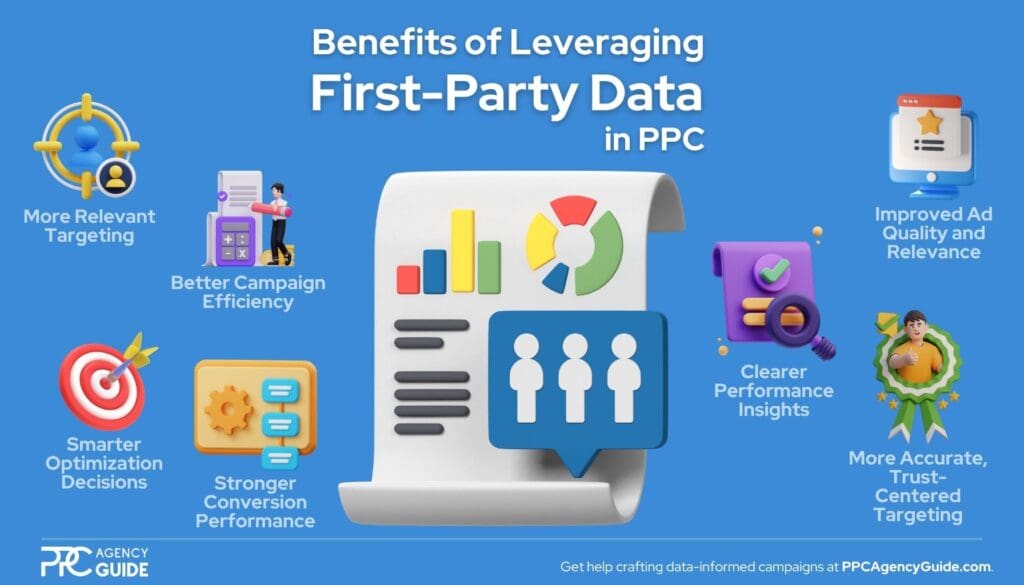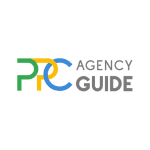
Whether you’re looking for ways to improve your pay-per-click (PPC) results or are concerned about how newer privacy laws are impacting your ability to market effectively, first-party data should be on your radar. However, confusion over what it is, how it works, and how to implement strategies that leverage first-party data in PPC and other initiatives often prevents businesses from moving forward.
In this guide, we break these concepts down simply, so they’re easy to understand and you can begin improving your results right away.
First-Party Data is Not New, But Its Importance is Growing
First-party data is information you gather directly from your customers, website visitors, and other individuals who interact with your business directly. For instance, if your website has forms for leads or customers to fill out, the information they provide is considered first-party data. Information you track on the back end when those forms are submitted, such as the UTM data, conversion page, and date, is also first-party data.
First-Party vs. Third-Party Data
In order to understand what makes first-party data special, it helps to compare it to third-party data.
First-Party Data
As mentioned, first-party data is the data that your business collects directly from people through interactions like form submissions, sales transactions, or website activity. This data is uniquely yours, highly reliable, and accurately reflects your real customer base.
Third-Party Data
On the other hand, third-party data is collected by external sources. In most cases, the third party is a data aggregator. For instance, the credit bureaus, Experian and Equifax, sell marketing data segments such as household makeup and buying intent.
While you may not work directly with these companies, you’ve probably benefited from them because they sell the data to advertising firms, allowing you to run targeted PPC ads, purchase email lists, and more. The data is widely available, but it lacks the precision and personalization of your own first-party data.
Most Consumers Have Privacy Concerns
The vast majority of consumers have concerns about their data and privacy. For instance, in the U.K., 75 percent of people report having concerns about online privacy, according to the Data and Marketing Association. Meanwhile, 81 percent of Americans say they’re concerned about how companies use the data they collect about them, according to Pew Research. And, a similar Canadian study shows that 91 percent have at least some concern about their data being used to create marketing profiles or for identity theft, the Office of the Privacy Commissioner reports.
Governments Are Stepping Up with New Privacy Protections
As a result, governments are stepping up to enact new privacy laws. Key regulations that impact businesses include the General Data Protection Regulation (GDPR) in Europe and the Personal Information Protection and Electronic Documents Act (PIPEDA) in Canada. While the U.S. does not have similar federal policies, individual states have their own. For instance, the California Consumer Privacy Act (CCPA) protects those in the Golden State.
Platforms Are Adjusting for Privacy in PPC Campaigns and Digital Marketing
This, in turn, has created pressure on various aggregators and platforms to create new policies. Even if you don’t follow the news, you may have noticed when iPhone apps first started giving you the option to opt out of tracking. And, silently, in the background, browsers like Safari and Firefox started blocking third-party cookies by default, thus preventing organizations from tracking users across websites.
That’s not to say third-party data is going away. But, how it looks and works is changing. For instance, rather than being able to trace all types of data to a single person, some platforms are moving to local tracking within your browser and adding category-level tags like “Fitness” or “Travel.”
Moreover, Goliaths like Google will continue to gather massive amounts of data across its ecosystem, which includes tools like Search, YouTube, and Gmail. And, although they may not sell or share it, it will still help power their advertising tools, allowing for more targeted campaigns.
You Must Also Consider PPC Privacy Compliance
As you begin thinking about how to collect and apply first-party data in your advertising, it’s important to consider the additional layer of privacy rules that come into play when running PPC campaigns.
Even though the data comes directly from your audience, it must still be collected and used in ways that meet legal requirements and platform standards. This includes securing proper consent, disclosing data use in your privacy policy, and honoring user preferences.
Most platforms require advertisers to use privacy-compliant data in PPC campaigns. For example, if you upload a list of contacts to build an audience or run remarketing ads, you may be asked to confirm how the data was obtained and whether users agreed to receive personalized advertising.
When planning how to use first-party data, PPC workflows should also be reviewed to ensure your targeting, measurement, and remarketing strategies align with both regulatory expectations and platform rules.
There Are Many Benefits of First-Party Data in PPC Campaigns
As third-party data becomes less reliable and harder to access, first-party data is quickly becoming one of the most valuable assets your business can leverage in digital advertising. Before we get into the mechanics behind using it, let’s take a quick look at why it’s worth investing in.

More Relevant Targeting
First-party data gives you visibility into real customer interests and actions, which allows you to create highly specific audience segments. This makes using first-party data for PPC targeting more effective than relying on third-party sources or broad demographic filters.
Better Campaign Efficiency
Because you’re basing decisions on verified user behavior, your ads are more likely to reach people who are ready to act. That’s a key reason why marketers emphasize the benefits of first-party data in PPC when planning spend.
Smarter Optimization Decisions
Tracking the relationship between ad engagement and customer behavior can guide your decisions regarding bidding, timing, and creative updates. This type of campaign optimization with data leads to more informed decisions and a stronger return on investment (ROI).
Stronger Conversion Performance
The ability to tailor messaging to what customers actually care about is a major driver of success. One of the core benefits of first-party data in PPC campaigns is that it allows for more precise message matching, which naturally lifts conversion rates.
Improved Ad Quality and Relevance
The mechanics behind how first-party data enhances PPC ads are simple. When you know what your audience is interested in and where they are in the buying process, you can craft messaging that speaks directly to their needs.
Clearer Performance Insights
First-party data helps you see how people move through your funnel across multiple touchpoints. That’s a critical factor in how first-party data improves PPC performance, especially when you’re trying to spot friction points or scale what’s working.
More Accurate, Trust-Centered Targeting
In a privacy-conscious environment, data-driven ads that rely on consented, first-party sources give you a lasting edge. Customers are more likely to engage when messaging is relevant and comes from a brand they already trust.
Develop a First-Party Data Strategy Before Beginning
Before you begin collecting information or running ad campaigns, it’s important to take a step back and define your strategy. First-party data can improve PPC performance significantly, but it’s most effective when used with a clear plan.
Start by Defining the Role of Data in Your Campaigns
Think about what you want your data to do. Are you hoping to retarget visitors who didn’t convert? Do you want to build more accurate lookalike audiences? Are you trying to personalize messaging based on user behavior?
Clarifying your goals upfront will help you determine what types of data to collect, which systems you’ll need to organize it, and how that information will support your larger marketing efforts.
Align Data Strategy with Business and Campaign Goals
Your first-party data strategy should connect directly to broader business objectives. For example, if your sales team is focused on increasing revenue from existing customers, your data plan might prioritize tracking post-purchase behavior and upsell opportunities.
On the campaign side, your goals might focus on lowering acquisition costs, improving conversion rates, or increasing customer lifetime value. These goals should guide what types of data you collect and how you segment your audiences.
Consider the Systems and Teams Involved
Your data strategy should also account for where your data lives, who manages it, and how it flows between tools.
- Data Collection Points: Determine whether you’ll gather information through website forms only or also from other channels such as app usage, live chat, or customer service interactions.
- Internal Access and Use: Clarify which teams will use the data, whether it’s limited to marketing or extends to sales, support, or leadership.
- Tools for Managing First-Party PPC Data: Assess whether your current systems can handle collection, organization, and audience building, or if new tools or processes are needed.
Keep Privacy and Consent in View from the Start
Regulations and platform requirements are increasingly strict, so your strategic planning should include how you’ll gain consent and communicate data use to your audience.
Get Specific on How You Plan to Collect and Store Information
Before you can use first-party data to power your ad campaigns, you need a reliable system for collecting and organizing it.
First-Party Data Comes from the Interactions You Already Have
You’re probably already collecting first-party data for ad targeting, even if you aren’t putting it to use just yet. In most cases, the data you need is already being generated by your audience. The key is to recognize which touchpoints provide value and ensure those signals are being captured consistently.

- Website Forms: Contact forms, newsletter sign-ups, and gated resources are common first-party data sources. Be sure these forms feed directly into your CRM or marketing platform.
- E-Commerce Behavior: Page views, cart activity, and purchase history can all be used to build intent-based segments.
- Customer Engagement: Email activity, live chat conversations, loyalty program usage, and app interactions all help shape a more complete view of your audience.
The Right Tools Help You Capture and Manage Data Effectively
Once you’ve identified your data sources, the next step is to ensure you have the infrastructure to manage them. Most businesses utilize a combination of first-party data tools that work in tandem.
- CRMs and Automation Platforms: Tools like HubSpot, Salesforce, and Zoho are commonly used to capture lead and customer information in real time.
- Analytics and Tag Management: Platforms such as Google Analytics and Google Tag Manager help track user behavior and connect data across systems.
- Compliance and Consent Solutions: Consent management tools play an important role in ensuring that data collection remains privacy-compliant.
Organization Turns Raw Data into Actionable Insights
A strong organization is one of the most important components of collecting first-party data for PPC campaigns. It ensures that the insights you generate are accurate, the audiences you build are meaningful, and the campaigns you launch are grounded in reliable information.
- Segmentation and Tagging: Grouping users by behavior, funnel stage, or interest allows for more personalized messaging and remarketing.
- Clean Data Practices: Standardizing naming conventions, timestamps, and field usage makes it easier to maintain consistency across systems.
- Data Syncing and Integrations: Using tools for organizing first-party data ensures that the right information reaches the right platform, whether it’s for reporting, targeting, or automation.
Maximize Your Results by Integrating First-Party Data in Your Campaigns
Once your first-party data is collected and organized, you can begin using it to improve how you reach and engage your audience through paid search and display. This step transforms raw data into measurable outcomes by helping you build better audiences, deliver more relevant ads, and keep your campaigns closely aligned with real behavior.
Drive Precision with Audience Segmentation Using First-Party Data
The most immediate use case for first-party data is audience segmentation. Rather than targeting broad demographic groups or general interest categories, you can define audiences based on how people actually engage with your business.
- Recent Activity: You might create an audience of people who viewed pricing pages or added items to their cart in the last seven days.
- Behavioral Traits: Visitors who consistently explore a specific product category can be grouped and served tailored offers.
- Customer Lifecycle: Segments can include new leads, existing customers, lapsed buyers, or high-LTV clients.
More advanced advertisers also apply audience segmentation with first-party data to build lookalike audiences, suppress ads to recent converters, or vary creative based on funnel stage.
Improve PPC Audience Targeting
Upload your segmented lists to platforms like Google Ads or Meta. This will allow you to focus your budget on people who have already shown interest, so your PPC audience targeting becomes more precise and effective.
- Personalized Ad Delivery: Serve offers tailored to users who downloaded a resource but didn’t convert.
- Exclusion-Based Efficiency: Remove existing customers from prospecting campaigns to avoid wasted spend.
- Priority Targeting: Direct your ad delivery toward high-value audience segments based on engagement history.
Supercharge Your PPC Retargeting
Another high-impact use case is retargeting. Advertisers who focus on using data for PPC retargeting strategies often see higher return on ad spend and stronger re-engagement because the messaging is built on context. Rather than showing the same generic ad to everyone who bounced from your site, you’ll create highly relevant follow-up campaigns based on actual behavior.
- Cart Recovery Campaigns: When you’re retargeting with data, you can reach users who abandoned their carts with product reminders or limited-time discounts.
- Content Sequencing: Connect with blog readers and provide them with next-step content such as case studies, testimonials, or comparison pages.
- Upgrade Incentives: Follow up with trial users through ads that promote plan upgrades or long-term benefits.
Many platforms also support retargeting strategies with first-party data that allow you to define very specific re-entry conditions, such as serving ads only after a user has visited a page more than once or returned within a defined time frame.
Analyze Your Results and Continue to Optimize Campaigns
Once your campaigns are running, the next step is evaluating performance. Here, first-party data provides the context needed to interpret results more accurately and make informed decisions moving forward.
Use Customer Behavior Metrics to Track PPC Campaign Success
Traditional metrics like click-through rates and cost per click are still useful, but first-party data helps you move beyond surface-level stats. When you know what a specific audience segment did before and after seeing your ad, you can better assess what’s working and why.
- Behavior-Based Insights: First-party data allows you to see how different groups behave after clicking, such as time on site, bounce rates, or actions taken.
- Segment Performance Trends: Comparing results by audience shows you which groups convert, which linger, and which exit early. Perform a PPC data analysis to find opportunities for creative or landing page adjustments.
- Attribution Clarity: Instead of relying solely on platform-reported conversion paths, you can connect touchpoints and follow the journey with more precision using your own data.
Focus on the Metrics That Connect to Business Goals
PPC metrics tracking should be guided by your campaign objectives, as the most valuable insights come from measuring progress toward your actual goals.
- Cost Per Qualified Lead: This tracks how much you’re paying to acquire leads that meet your internal criteria for sales-readiness.
- Revenue by Audience Segment: Use this to identify which customer groups drive the most value and where to reinvest.
- Time to Conversion: Measure how long it takes for users to convert after seeing or clicking an ad, so you can gain insight into sales cycle efficiency.
- Ad Engagement by Creative Type: Learn which ad formats or messages resonate most with specific audiences.
Be Prepared to Address Common Challenges with First-Party Data in PPC
While first-party data is powerful, it does come with its own set of obstacles. Small teams, limited tech stacks, or messy data can all slow down progress. But most of these issues are manageable with the right approach.
Volume and Coverage Can Be Limited at First
If you’re new to first-party data, you may not have enough of it to build meaningful segments or power broader campaigns right away. That’s especially true if your site traffic is low or your audience hasn’t opted in to tracking yet.
- Start With What You Have: Focus on the highest-quality data sources first. such as purchase history or gated content downloads, and build from there.
- Use Broad Signals Strategically: If your volume is limited, consider targeting by behavior categories rather than granular audience traits.
- Combine with Platform Tools: Most ad platforms allow you to use your first-party lists to inform lookalike audiences or supplement broader campaigns.
Data Quality and Consistency Often Require Cleanup
Collecting data from multiple sources, such as forms, CRM entries, email platforms, and web analytics, can result in inconsistencies that make the data hard to use.
- Standardize Fields and Labels: Create a consistent structure for how fields like names, lifecycle stages, or interests are labeled and stored.
- Clean Up Older Records: Remove duplicates, outdated entries, or fields that no longer serve your segmentation strategy.
- Automate Where Possible: Use rules, workflows, or validation steps in your CRM or marketing platform to catch issues early.
Systems and Teams May Not Be Fully Integrated
Even with good data, campaigns can stall if teams are using disconnected tools or working in silos.
- Establish a Clear Owner: Assign someone to oversee your first-party data strategy and ensure alignment across marketing, sales, and support.
- Build Cross-Platform Workflows: Make sure your ad accounts, analytics tools, and CRM are synced, so data flows in both directions.
- Document Your Processes: Keep records of how your data is collected, segmented, and used in campaigns to reduce dependency on individual team members.
Get Help Developing Your First-Party Data Strategy
There’s no denying that leveraging first-party data in PPC is a next-level tactic. Even if you understand the basics of it, it’s not usually a one-person job. PPC agencies will typically have someone guiding your collection strategy and working with your internal team to ensure accuracy. You’ll likely have experts on each platform collaborating with them and managing the technical setup of ads. Plus, there will be creatives handling different aspects from ad copy creation to image sourcing or video creation. This helps ensure that you get the best results possible and can deploy ads quickly, so you can seize opportunities.
If a lack of comfort with these strategies, team limitations, or time are holding you back from leveraging first-party data in PPC, it’s worthwhile to partner with an experienced agency. We can help shorten the search by matching you with vetted agencies who understand what you want to accomplish and have a strong track record for success. To get started, request a complimentary consultation.
FAQs on First-Party Data in PPC
What are the key metrics for data-driven PPC results?
Key metrics for data-driven PPC results include cost per qualified lead, revenue by audience segment, time to conversion, and engagement by creative type. These metrics go beyond basic clicks and impressions, offering insights into which strategies generate meaningful outcomes and where optimization efforts should be focused.
How does first-party data improve PPC campaign performance?
First-party data improves PPC performance by enabling more accurate audience targeting, personalized ad messaging, and better-informed optimization. Since it’s based on real user behavior, it allows advertisers to align campaigns with customer intent, reduce wasted spend, and improve conversion rates through highly relevant and timely outreach.
What are the benefits of using first-party data in PPC targeting?
Using first-party data in PPC targeting allows you to reach people based on their actual interactions with your business. This leads to more relevant ads, higher engagement, and better return on ad spend. It also supports segmentation, remarketing, and message personalization based on real user behavior.
How do you collect first-party data for PPC campaigns?
You can collect first-party data for PPC campaigns through website forms, email sign-ups, purchase records, user behavior tracking, and CRM integrations. The key is to gather data ethically with clear consent, then structure and store it in a way that supports audience segmentation and campaign targeting.
What tools help organize and manage first-party PPC data?
Common tools for organizing first-party PPC data include CRMs like Salesforce or HubSpot, analytics platforms like Google Analytics, and tag managers like Google Tag Manager. These systems help structure, track, and connect data across teams and platforms, making it easier to activate in your campaigns.
How can you use first-party data for audience segmentation in PPC?
First-party data can be used to segment audiences by behaviors, lifecycle stages, purchase history, or engagement level. These segments allow advertisers to serve tailored ads to specific groups, improve message relevance, and deliver better results by aligning offers with what each audience group cares about most.
What are the challenges of using first-party data in PPC campaigns?
Challenges include limited data volume, inconsistent data quality, and fragmented systems. Small audiences may not meet platform minimums, and messy or siloed data can make segmentation difficult. Addressing these issues requires proper tools, standardized processes, and close collaboration between marketing, sales, and tech teams.
What is the best way to use first-party data for PPC retargeting?
The most effective way to utilize first-party data for PPC retargeting is to create segments based on user behavior, such as cart abandoners or content viewers, and serve them tailored ads. This approach enhances relevance, improves re-engagement, and guides users through the next step in the buying journey.
How do you compare PPC results using first-party data?
Comparing PPC results using first-party data means evaluating performance across audience segments or behavioral groups. For example, you can assess which audiences convert faster or engage longer. This approach reveals deeper insights into campaign effectiveness and helps you prioritize strategies that deliver better returns.


















